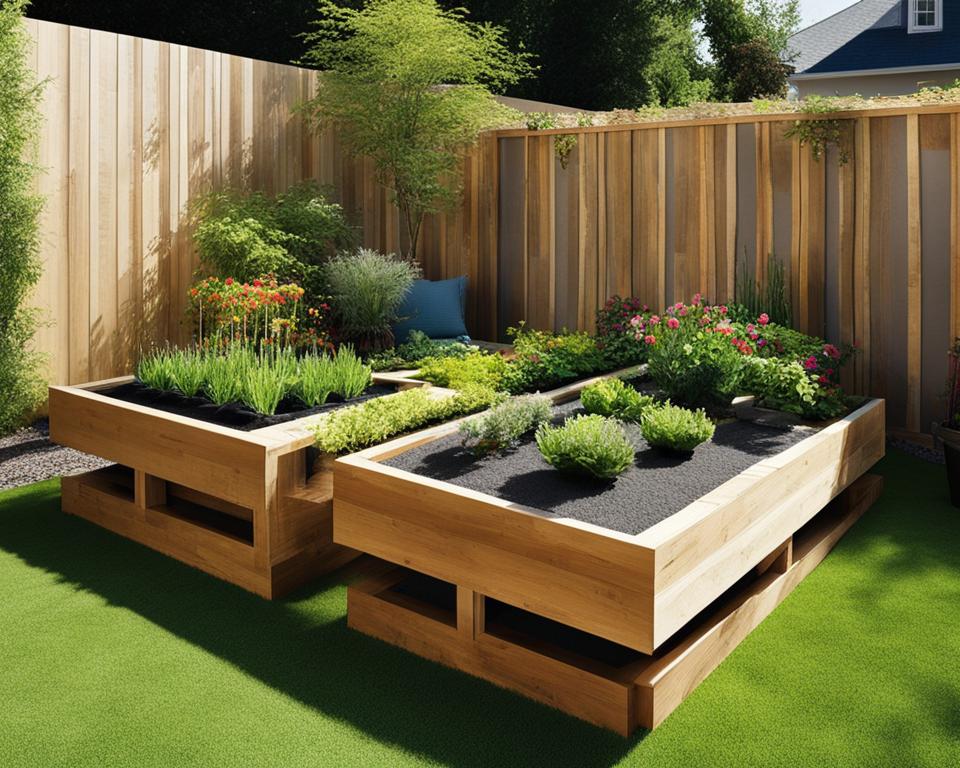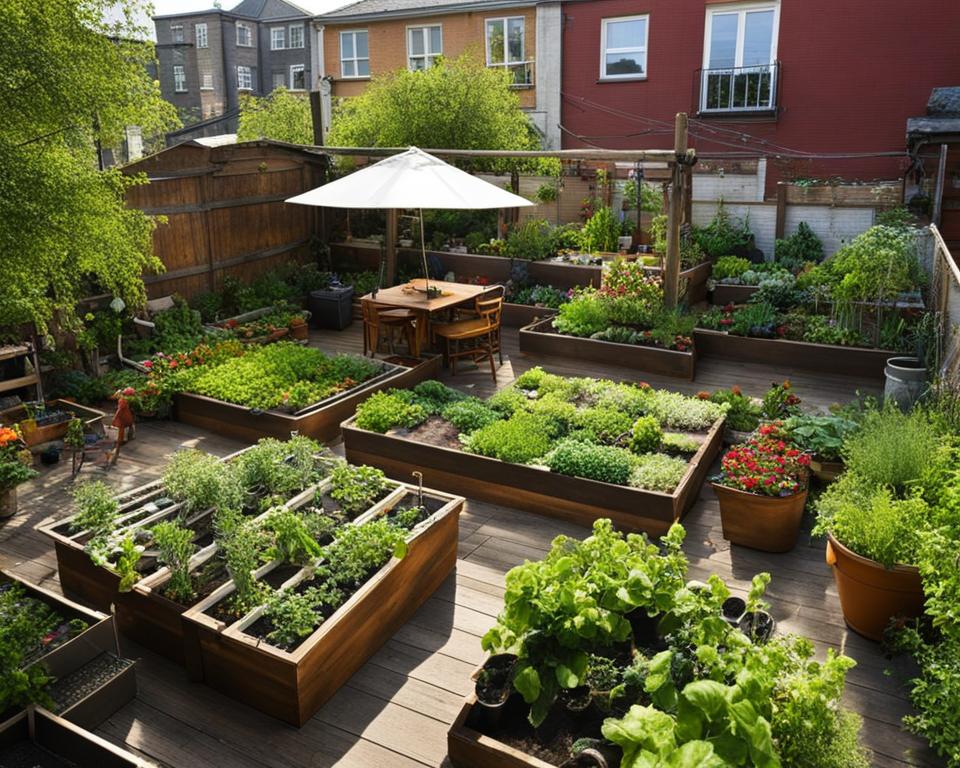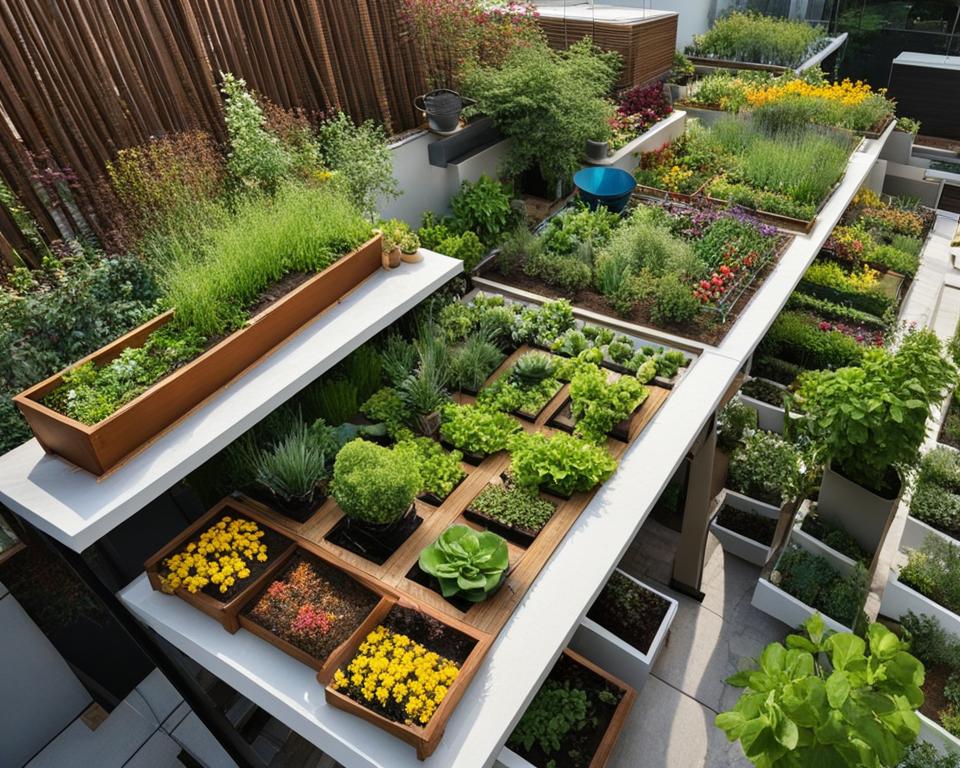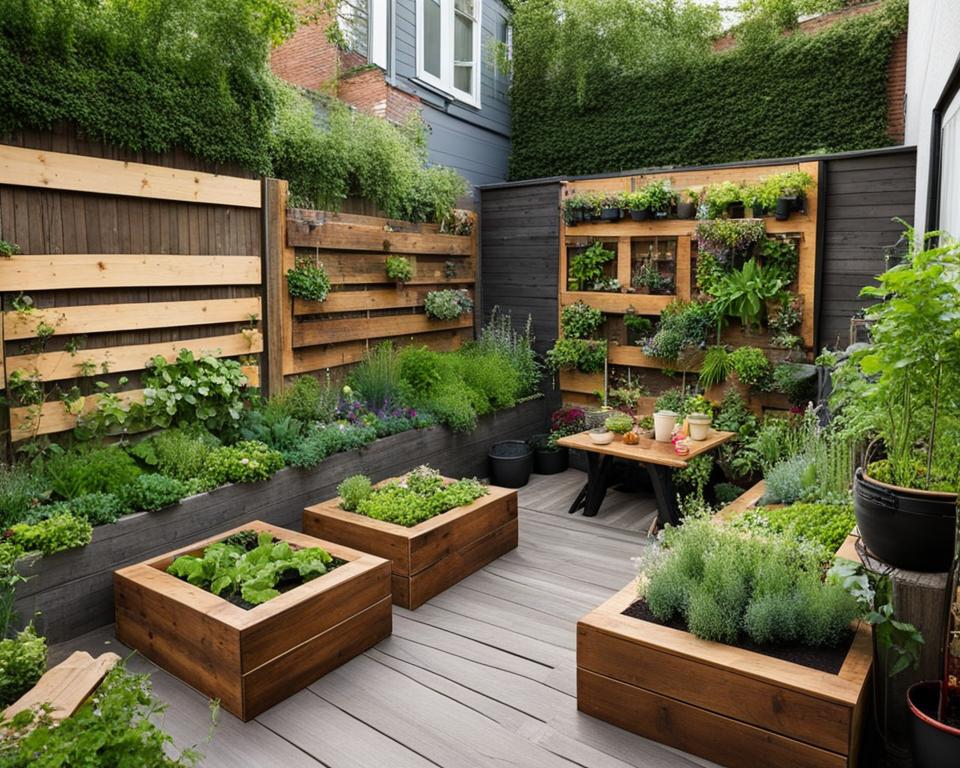Welcome to my easy guide on mastering urban DIY backyard gardening! If you’re looking to transform your outdoor space into a lush oasis, you’ve come to the right place. In this guide, I’ll share all the tips and tricks you need to know to create a thriving urban garden. From urban garden ideas to fun and creative DIY gardening projects, we’ll cover it all.
Whether you’re a beginner or have some experience with gardening, this guide is designed to help you succeed. With urban gardening becoming more popular, it’s the perfect time to discover how you can turn a small backyard into a green sanctuary. Follow along as I share my knowledge and experience to help you create an urban garden that will impress your friends and neighbors.
Getting Started: Site Selection for Your Urban Garden
When it comes to backyard gardening, selecting the right site for your urban garden is crucial. Whether you’re a beginner or looking for inspiration, these backyard gardening tips will help you ensure the success of your urban garden.
Factors to Consider
- Sunlight: Choose a location that receives ample sunlight throughout the day. Most plants require at least six hours of direct sunlight to thrive.
- Access: Consider how easy it is to access your garden. Ensure there’s enough space to navigate and tend to your plants comfortably.
- Visibility: If you want to showcase your garden, choose a site that is visible to you and your guests. It can be a delightful addition to your outdoor space.
- Grade: Pay attention to the slope of the land. If it’s too steep, it may cause drainage issues or make it challenging to work in the garden.
- Access to Water: Having a water source nearby is essential for convenient watering. Consider installing a rain barrel or setting up a hose connection.
By considering these factors, you can create an ideal site for your urban garden. Remember, site selection is the foundation of a successful garden and will set you up for a thriving and enjoyable gardening experience.
Table: Factors to Consider for Site Selection
| Factors | Tips |
|---|---|
| Sunlight | Choose a location with at least six hours of direct sunlight. |
| Access | Ensure there’s enough space to navigate and tend to your plants comfortably. |
| Visibility | Consider a site that is visible to you and your guests. |
| Grade | Pay attention to the slope of the land to avoid drainage issues. |
| Access to Water | Have a water source nearby for convenient watering. |
Choosing the Right Garden Size and Configuration
When it comes to DIY garden design, choosing the right garden size and configuration is essential. It not only affects the overall aesthetics of your urban garden but also determines its functionality. Consider the following factors to ensure you make the best choices for your space:
- The number of plots: Determine how many separate plots you want to have in your garden. This will depend on your available space and the variety of plants you wish to grow.
- Plot size: Decide on the size of each plot based on the plants you intend to cultivate. Some plants may require more space to spread their roots, while others can thrive in smaller areas.
- Dedicated foodbank plots: If you want to contribute to your community, consider including dedicated plots for growing food to donate to local food banks. This can be a rewarding way to make a positive impact in your neighborhood.
By carefully considering these factors, you can optimize your garden space and create a visually appealing and functional garden that meets your needs.
| Garden Size | Number of Plots | Plot Size | Dedicated Foodbank Plots |
|---|---|---|---|
| Small | 1 | 4′ x 4′ | No |
| Medium | 2 | 4′ x 8′ | No |
| Large | 3 | 4′ x 10′ | Yes |
Table: Different Garden Sizes and Configurations
As shown in the table above, you can choose the appropriate garden size, number of plots, plot size, and whether to include dedicated foodbank plots based on your preferences and available space.
Maximizing Space with Vertical Gardening
Another way to optimize your urban garden design is by incorporating vertical gardening techniques. Vertical gardening allows you to make the most of limited space by growing plants vertically, using walls, trellises, or hanging containers. This technique is particularly useful for small gardens or when you want to add more variety to your plant selection.
By utilizing vertical gardening, you can grow climbing plants such as tomatoes, cucumbers, or even flowers, adding visual interest and maximizing your overall garden yield.

Garden Bed Types
| Garden Bed Type | Description |
|---|---|
| Wood-Framed Beds | Garden beds framed with wood, providing a defined and organized look. Can be customized to fit any space. Popular materials include cedar and redwood for durability. |
| Container Gardens | Gardens created using containers such as pots or raised planters. Perfect for small spaces and can be arranged in multi-tiered displays. |
| Mounded Beds | Elevated garden beds with rounded edges, adding visual interest to the garden. Helps with water drainage and soil erosion. |
| Terraced Beds | Beds built into sloping terrain, often constructed with stone or wood. Adds dimension to the garden and provides stability. |
Get creative with your garden bed designs and structures. Experiment with different materials, shapes, and configurations to create a unique and personalized urban garden. By paying attention to these details, you can enhance the overall beauty and functionality of your DIY urban garden.
Soil Preparation and Quality for Urban Gardening
When it comes to urban gardening, soil preparation and quality play a crucial role in the success of your plants. Before you start planting, it’s important to assess the condition of your soil and make any necessary improvements. Conducting a soil test is a great way to determine the nutrient levels and potential contamination in your soil.
Based on the results of your soil test, you may need to add organic matter such as compost or new soil to improve its quality. Organic matter can help retain moisture, promote root development, and provide essential nutrients for your plants to thrive. Incorporating compost into your soil can also enhance its structure, allowing for better drainage and aeration.
Furthermore, it’s important to consider the pH level of your soil. Most plants prefer a slightly acidic to neutral pH, so adjusting the soil pH accordingly can benefit your plants’ growth. You can use soil amendments like lime or sulfur to raise or lower the pH, respectively.
Table: Soil Amendments
| Soil Amendment | Usage | Benefits |
|---|---|---|
| Lime | To raise pH in acidic soil | Improves nutrient availability, enhances microbial activity |
| Sulfur | To lower pH in alkaline soil | Enhances nutrient availability, prevents micronutrient deficiencies |
| Compost | To improve soil structure and fertility | Increases water retention, promotes beneficial microbial activity |
Remember to regularly monitor your soil’s moisture levels and adjust your watering schedule accordingly. Overly compacted soil can hinder root growth, so be sure to avoid excessive foot traffic in your garden. Taking the time to properly prepare and maintain your soil will set the foundation for a thriving urban garden.
Choosing the Right Plants for Your Urban Garden
Creating a beautiful and thriving urban garden starts with choosing the right plants. With the right selection, you can ensure that your garden not only looks stunning but also thrives in the unique conditions of an urban environment.
When selecting plants for your urban garden, consider the amount of sunlight the area receives. Some plants require full sun, while others can tolerate partial or even full shade. Observing the sun patterns in your garden will help you determine which plants will thrive in each area. For example, if you have a spot that receives direct sunlight for most of the day, opt for sun-loving plants like roses, lavender, or succulents.
Another important factor to consider is the wind patterns in your garden. Urban environments tend to have stronger winds compared to rural areas. Choose plants that can withstand these conditions, such as ornamental grasses, shrubs with sturdy branches, or wind-tolerant flowers like marigolds or zinnias.
Remember to consider the mature size and plant form when arranging your plants. Some plants may grow tall and block sunlight from smaller ones, so it’s important to plan accordingly. Grouping plants with similar heights and spreading out taller plants strategically can help ensure that each plant has adequate space to flourish.
To inspire you with urban garden ideas, here is a table showcasing a variety of plant options suitable for different urban garden conditions:
| Plant | Sunlight Requirement | Wind Tolerance | Height at Maturity |
|---|---|---|---|
| Rose | Full sun | Moderate | Tall |
| Lavender | Full sun | Tolerant | Medium |
| Succulents | Full sun | Tolerant | Low |
| Ornamental Grasses | Partial to full sun | High | Medium to tall |
| Marigolds | Full sun to partial shade | Tolerant | Medium |
| Zinnias | Full sun | Moderate | Medium |
Whether you have a small balcony garden or a larger backyard space, these plant options can help you create a stunning urban garden that fits your specific needs. By considering the sunlight, wind, and mature size of each plant, you can arrange them in a way that maximizes their beauty and ensures their health.
Remember to regularly water and care for your plants to keep them thriving, and don’t be afraid to experiment with different plant combinations to create a unique and personalized urban garden that reflects your own style and preferences.

Urban Garden Ideas:
Lorem ipsum dolor sit amet, consectetur adipiscing elit, sed do eiusmod tempor incididunt ut labore et dolore magna aliqua. Ut enim ad minim veniam, quis nostrud exercitation ullamco laboris nisi ut aliquip ex ea commodo consequat.
Duis aute irure dolor in reprehenderit in voluptate velit esse cillum dolore eu fugiat nulla pariatur. Excepteur sint occaecat cupidatat non proident, sunt in culpa qui officia deserunt mollit anim id est laborum.
Maintaining Your Urban Garden
Maintaining your urban garden is essential to ensure its health and productivity. By following a few urban gardening techniques and backyard gardening hacks, you can keep your garden thriving throughout the growing season.
Regular Watering
Watering your plants regularly is crucial, especially during hot and dry periods. Aim to provide deep watering rather than frequent shallow watering. This encourages the plants’ roots to grow deeper, making them more resilient to drought. Use a soaker hose or drip irrigation system to deliver water directly to the plant roots, minimizing evaporation and water waste. Monitor the moisture level of your soil regularly and adjust your watering schedule accordingly.
Fertilizing and Pest Control
Proper fertilization is essential for the healthy growth of your urban garden. Use organic fertilizers or compost to provide a balanced nutrient supply to your plants. Follow the instructions on the product labels or consult a local gardening expert for specific recommendations based on the plants you’re growing. Additionally, keep an eye out for common pests and diseases that can affect your plants. Implement natural pest control methods such as companion planting, introducing beneficial insects, or using organic pest repellents to minimize damage and promote a healthy ecosystem in your garden.
Pruning and Trimming
Regular pruning and trimming help maintain the shape and size of your plants, improving their overall health and appearance. Remove dead or diseased branches, as well as any crossed or crowded branches that may inhibit airflow and sunlight penetration. Prune flowering plants after their blooming period to encourage new growth. Use clean and sharp pruning tools to make clean cuts and minimize the risk of spreading diseases.
| Task | Frequency |
|---|---|
| Weeding | Weekly |
| Watering | As needed, 2-3 times per week |
| Fertilizing | Monthly |
| Pest Control | Ongoing as needed |
| Pruning and Trimming | Seasonal |

Regular maintenance tasks include weeding, watering, fertilizing, pest control, and pruning. Create a schedule to ensure you stay on top of these tasks. The table above provides a general guideline for the frequency of each task. However, adjust the frequency based on the specific needs of your plants and the prevailing weather conditions.
By implementing these urban gardening techniques and backyard gardening hacks, you’ll be able to maintain a beautiful and productive urban garden all year round. The effort you put into maintaining your garden will be well worth it when you see the bountiful harvests and vibrant blooms that result.
Enhancing Your Urban Garden
Now that you have created a thriving urban garden, it’s time to take it to the next level with some exciting enhancements. Adding additional features not only enhances the aesthetics of your garden but also makes it more functional and enjoyable. Here are some urban garden ideas and DIY gardening projects to inspire you.
Creating a Sitting Area
One of the best ways to enhance your urban garden is by creating a cozy sitting area. This can be a simple arrangement of outdoor chairs and a table, or you can get creative and build a custom seating area. Consider using recycled materials like pallets or repurposing old furniture to add a unique touch to your sitting area. It’s the perfect spot to relax and enjoy the beauty of your garden.
Building Arbors and Trellises
Arbors and trellises not only add visual interest to your urban garden but also provide support for climbing plants like vines and flowers. They can be made from wood or metal and can be customized to fit the style of your garden. Use them to create a stunning entrance or focal point, or to divide different areas of your garden. Let your creativity shine and create a beautiful structure that complements your plants.
Adding Plant Supports
As your plants grow, they may need support to prevent them from bending or breaking. Plant supports like stakes, cages, and hoops can help keep your plants upright and organized. You can make your own plant supports using materials like bamboo or wire, or purchase them from a garden supply store. Consider the height and growth habits of your plants when choosing the right support, and watch your garden flourish.
Whether you’re a beginner or an experienced gardener, these urban garden ideas and DIY gardening projects will help you enhance your urban garden. Take your outdoor space to new heights with sitting areas, arbors, trellises, and plant supports. Let your creativity and passion for gardening shine through as you transform your garden into a beautiful oasis.
Conclusion
Creating an urban DIY backyard garden can be a rewarding and enjoyable experience. With the right design, maintenance, and enhancements, you can transform your outdoor space into a lush and beautiful oasis. Follow my easy guide to master urban DIY backyard gardening and enjoy the benefits of having your own urban garden. Start today and watch your garden thrive!
FAQ
What is urban DIY backyard gardening?
Urban DIY backyard gardening is the practice of transforming your outdoor space into a lush oasis using do-it-yourself techniques. It allows you to create and maintain a garden in an urban setting, even if you have limited space.
How do I start an urban garden?
To start an urban garden, you need to select the right site. Consider factors like sunlight, access, visibility, grade, and access to water. These backyard gardening tips will help you create a successful urban garden, whether you’re a beginner or looking for inspiration.
How do I design my urban garden beds?
Designing your garden beds and structures is an important aspect of urban gardening techniques. Consider the shape, dimensions, and materials for your garden beds. You can choose wood-framed beds, mounded beds, terraced beds, or even container gardens. These DIY urban garden tips will guide you in creating a well-designed and functional garden space.
How do I prepare the soil for my urban garden?
Soil preparation and quality are essential for successful urban gardening. Conduct a soil test to determine the nutrient levels and potential contamination in your soil. You may need to add compost or new soil to improve the soil quality. These DIY garden design tips will help you create a healthy and fertile soil environment for your plants.
What plants should I choose for my urban garden?
Choosing the right plants for your urban garden is crucial for its success. Consider the sunlight and wind patterns in your garden to ensure you select plants that thrive in the conditions. Additionally, consider the mature size and plant form to arrange your plants effectively. These urban garden ideas and backyard gardening tips will help you create a beautiful and thriving garden.
How do I maintain my urban garden?
Maintaining your urban garden is essential to keep it healthy and thriving. Regular watering, fertilizing, and pest control are crucial tasks. Additionally, consider the pruning and trimming needs of your plants. These urban gardening techniques and backyard gardening hacks will help you maintain a beautiful and productive garden.
How can I enhance my urban garden?
Enhancing your urban garden with additional features can make it even more enjoyable. Consider adding features like sitting areas, arbors, trellises, and plant supports. You can also create a potting table or tool shed to store your gardening tools. These urban garden ideas and DIY gardening projects will inspire you to make your garden even better.

